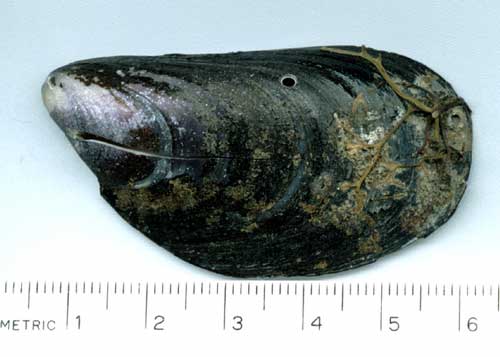 By Ned Rozell April 28, 2005
Or was it? Norton, of UAF's School of Fisheries and Ocean Sciences, had lived in Barrow for a decade, during which time he'd roam the beach after storms and pick up mussels blown ashore. Though the Barrow mussels first seemed like newcomers to the area, Norton thinks the blue shellfish may not be the slam-dunk indicator of climate change that other scientists have claimed.  up on a beach at Barrow in 1995. Dave Norton photo.
"(Some researchers) think the blue mussel is a wonderful temperature indicator and it's moving north because of rising sea temperatures," Norton said. "We go against the prominent way of thinking." Norton means himself, Howard Feder of UAF and Jonathan Geller of Moss Landing Marine Laboratories in California. They authored a paper in which they show evidence that mussels have been living in Alaska's arctic for about the last 3 million years, "undeterred by cold water." Three summers ago Norton plucked his own proof from the crumbling permafrost banks of the Colville River-a fossilized blue mussel shell 2.5 to 3 million years old. Blue mussels cling to rocks on intertidal zones in the Northern Hemisphere, where they feed on microscopic plankton. They stick to rocks, kelp rope and other surfaces using "byssal threads," described by researchers as "nature's little bungee cords." The threads can stretch up to twice their length and retain an iron grip. Though mussels might seem like the most immobile of creatures, tiny mussel larvae travel long distances on ocean currents, as do adult mussels that reattach their byssal threads when they reach a new home. Mussels live in great numbers on Alaska's southern coasts, and Norton's experience there helped him come up with a different theory for why the shellfish would appear so far north. By thinking of where they'd seen the densest beds of mussels in Prince William Sound, Norton and his colleagues theorized that the blue mussel might be indicators of areas where fresh water flows into salt water. Many of the mussels in the waters off Alaska's north slope live in estuaries where they receive a dose of both fresh and salt water. Their predators, including starfish and snails, can't take fresh water. "Maybe their tolerance for fresh water allows them to duck predators," said Norton, who noted that starfish-which pry mussel shells open-and moon snails-which drill a hole through mussel shells and suck out the innards-can mow through a bed of mussels in short order. "Those predators nail 'em when the mussels are in a predator environment. They're very efficient." Mussels may have populated northern seas by slowly moving from estuary to estuary, taking advantage of periodic floodings of the Bering Land Bridge to expand their ranges to the circumpolar north, Norton said. The Svalbard mussels may have existed in the recent past, but predators or storms may have wiped the mussels out before the recent comeback. A larger issue than the range of blue mussels is that scientists must use a bit of caution when interpreting what they find, Norton said. He considers himself an "agnostic" on the subject of global warming and notes that while some proof of warming seems compelling, other signs, such as the discovery of blue mussels at the top of the world, might not point to a warmer planet.
|